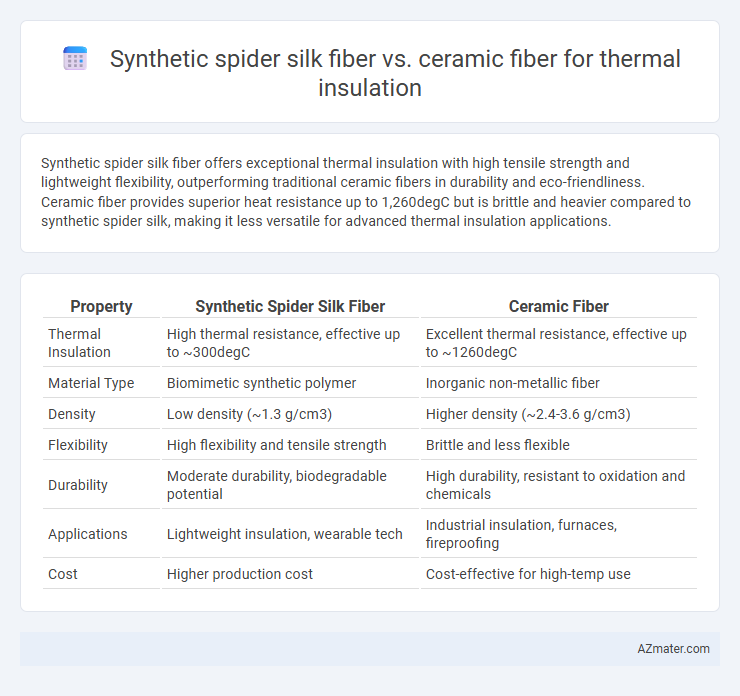Synthetic spider silk fiber offers exceptional thermal insulation with high tensile strength and lightweight flexibility, outperforming traditional ceramic fibers in durability and eco-friendliness. Ceramic fiber provides superior heat resistance up to 1,260degC but is brittle and heavier compared to synthetic spider silk, making it less versatile for advanced thermal insulation applications.
Table of Comparison
| Property | Synthetic Spider Silk Fiber | Ceramic Fiber |
|---|---|---|
| Thermal Insulation | High thermal resistance, effective up to ~300degC | Excellent thermal resistance, effective up to ~1260degC |
| Material Type | Biomimetic synthetic polymer | Inorganic non-metallic fiber |
| Density | Low density (~1.3 g/cm3) | Higher density (~2.4-3.6 g/cm3) |
| Flexibility | High flexibility and tensile strength | Brittle and less flexible |
| Durability | Moderate durability, biodegradable potential | High durability, resistant to oxidation and chemicals |
| Applications | Lightweight insulation, wearable tech | Industrial insulation, furnaces, fireproofing |
| Cost | Higher production cost | Cost-effective for high-temp use |
Introduction to Advanced Thermal Insulation Materials
Synthetic spider silk fiber exhibits exceptional tensile strength and elasticity, making it a promising candidate for advanced thermal insulation materials due to its lightweight and durable nature. Ceramic fiber, renowned for its high-temperature resistance and low thermal conductivity, remains a leading choice for insulating applications in extreme heat environments. Comparing these materials highlights the trade-off between the mechanical flexibility of synthetic spider silk and the superior heat resilience of ceramic fibers in next-generation thermal insulation solutions.
Overview of Synthetic Spider Silk Fiber
Synthetic spider silk fiber exhibits exceptional thermal insulation properties due to its highly organized protein structure, which provides low thermal conductivity and high tensile strength. Unlike ceramic fiber, synthetic spider silk is lightweight, flexible, and biodegradable, making it suitable for advanced insulation applications in wearable technology and aerospace. Research highlights its superior thermal stability and moisture management compared to traditional ceramic fibers, enhancing comfort and durability in varying environmental conditions.
Overview of Ceramic Fiber
Ceramic fiber is a high-temperature-resistant material composed mainly of alumina and silica, offering excellent thermal insulation in industrial applications up to 1400degC. Its low thermal conductivity, lightweight structure, and chemical stability make it ideal for furnace linings, kilns, and heat shields. Compared to synthetic spider silk fiber, ceramic fiber provides superior thermal resistance but lacks the flexibility and tensile strength of bioengineered fibers.
Thermal Conductivity: Spider Silk vs Ceramic Fiber
Synthetic spider silk fiber exhibits significantly lower thermal conductivity compared to ceramic fiber, making it a superior insulator for applications demanding minimal heat transfer. With thermal conductivity values typically around 0.04 W/m*K, synthetic spider silk offers enhanced thermal resistance relative to ceramic fibers, which generally range from 0.1 to 0.3 W/m*K depending on composition and structure. This marked difference enables synthetic spider silk to outperform ceramic fiber in energy-efficient thermal insulation solutions where lightweight and flexible materials are advantageous.
Mechanical Strength and Flexibility
Synthetic spider silk fiber exhibits superior mechanical strength and flexibility compared to ceramic fiber, making it highly effective for thermal insulation applications requiring durability and resilience under stress. Its tensile strength can reach up to 1.3 GPa, surpassing many traditional materials, while maintaining exceptional elasticity with elongation at break around 30%. Ceramic fiber, although excellent in thermal resistance withstanding temperatures above 1,200degC, tends to be brittle and lacks the flexibility of synthetic spider silk, limiting its use in dynamic environments where mechanical stress is frequent.
Heat Resistance and Performance in Extreme Environments
Synthetic spider silk fiber exhibits exceptional heat resistance and maintains strength at temperatures up to 300degC, making it highly effective for thermal insulation in moderate extreme environments. Ceramic fiber, by contrast, can withstand temperatures exceeding 1,200degC and provides superior thermal insulation in ultra-high temperature applications such as furnaces and aerospace components. The choice between synthetic spider silk and ceramic fiber depends on the required thermal threshold and environmental conditions, with ceramic fiber leading in extreme heat performance and synthetic spider silk offering flexibility and durability under less intense thermal stress.
Environmental Impact and Sustainability
Synthetic spider silk fiber offers a lower environmental impact compared to ceramic fiber due to its biodegradability and renewable production from bioengineered proteins, reducing reliance on non-renewable mineral resources. Ceramic fiber, often derived from aluminosilicate minerals, has significant energy-intensive manufacturing processes contributing to higher carbon emissions and long-term waste persistence. The sustainability advantage of synthetic spider silk lies in its potential for carbon-neutral cycles and minimal ecological footprint, making it preferable for eco-conscious thermal insulation applications.
Applications in Industry and Construction
Synthetic spider silk fiber exhibits exceptional thermal insulation properties combined with lightweight flexibility and high tensile strength, making it ideal for advanced aerospace and wearable technology applications. Ceramic fiber, known for its superior heat resistance and non-combustibility, is extensively used in high-temperature industrial processes such as furnace linings, kilns, and fireproofing in construction. These materials serve distinct roles where synthetic spider silk enhances insulation in lightweight structures while ceramic fiber provides robust protection in extreme thermal environments.
Cost Comparison and Scalability
Synthetic spider silk fiber generally incurs higher production costs compared to ceramic fiber due to complex bioengineering and slower manufacturing processes. Ceramic fibers benefit from established large-scale industrial production methods, offering lower cost per unit and easier scalability for thermal insulation applications. While synthetic spider silk promises superior mechanical properties, ceramic fiber remains more cost-effective and scalable for mass thermal insulation deployment.
Future Trends and Research Directions
Synthetic spider silk fiber exhibits superior tensile strength, flexibility, and biodegradability compared to ceramic fiber, positioning it as a leading candidate for next-generation thermal insulation in aerospace and wearable technologies. Emerging research prioritizes enhancing its thermal resistance through molecular engineering and hybrid composites to rival the high-temperature stability of traditional ceramic fibers. Future trends emphasize scalable production methods and eco-friendly processing to integrate synthetic spider silk fibers into sustainable, high-performance thermal insulation systems.

Infographic: Synthetic spider silk fiber vs Ceramic fiber for Thermal insulation
 azmater.com
azmater.com